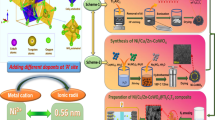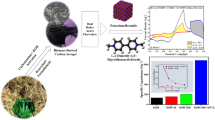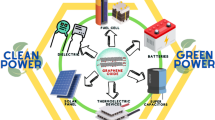Abstract
Graphene-based nanocomposites have been one of the most attractive electrode materials of supercapacitors. But in most cases, graphene-based nanocomposites always use single nanoparticle as active material, which cannot meet the increasing demand for next generation of energy storage devices. In the present paper, we prepared Fe2O3–Ni(OH)2/graphene nanocomposite by simple one-step hydrothermal method. The dual-particle system reveals a synergistic effect between Fe2O3 and Ni(OH)2, i.e., Ni(OH)2 can enhance the electrical conductivity of Fe2O3, and then Fe2O3 can act as electrical conductivity bridges between Ni(OH)2 nanoparticles and RG. As a result, the Fe2O3–Ni(OH)2/graphene nanocomposite presents impressing electrochemical performance, including high specific capacitance (~857 F/g), good rate capability, and outstanding cycling stability (after 5000 cycles, 100 % retention).










Similar content being viewed by others
References
Su DS, Schlögl R (2010) Nanostructured carbon and carbon nanocomposites for electrochemical energy storage applications. ChemSusChem 3:136–168
Wang DW, Li F, Liu M, Lu GQ, Cheng HM (2008) 3D aperiodic hierarchical porous graphitic carbon material for high-rate electrochemical capacitive energy storage. Angew Chem Int Ed 47:373–376
Li Z, Wu D, Liang Y, Fu R, Matyjaszewski K (2014) Synthesis of well-defined microporous carbons by molecular-scale templating with polyhedral oligomeric silsesquioxane moieties. J Am Chem Soc 136:4805–4808
Xu F, Cai R, Zeng Q et al (2011) Fast ion transport and high capacitance of polystyrene-based hierarchical porous carbon electrode material for supercapacitors. J Mater Chem 21:1970–1976
Liu C, Li F, Ma LP, Cheng HM (2010) Advanced materials for energy storage. Adv Mater 22:E28–E62
Lv W, Tang DM, He YB et al (2009) Low-temperature exfoliated graphenes: vacuum-promoted exfoliation and electrochemical energy storage. ACS Nano 3:3730–3736
Zhang LL, Zhao XS (2009) Carbon-based materials as supercapacitor electrodes. Chem Soc Rev 38:2520–2531
Nishihara H, Kyotani T (2012) Templated nanocarbons for energy storage. Adv Mater 24:4473–4498
Zhu Y, Murali S, Stoller MD et al (2011) Carbon-based supercapacitors produced by activation of graphene. Science 332:1537–1541
Liang Y, Liang F, Zhong H, Li Z, Fu R, Wu D (2013) An advanced carbonaceous porous network for high-performance organic electrolyte supercapacitors. J Mater Chem A 1:7000–7005
Li ZH, Wu DC, Huang X et al (2014) Fabrication of novel polymeric and carbonaceous nanoscale networks by the union of self-assembly and hypercrosslinking. Energy Environ Sci 7:3006–3012
Chen AB, Yu YF, Xing TT, Wang RJ, Zhang Y, Li Q (2015) Synthesis of graphitic carbon spheres for enhanced supercapacitor performance. J Mater Sci 50:5578–5582. doi:10.1007/s10853-015-9106-x
Chang L, Wei W, Sun K, Hu YH (2015) 3D flower-structured graphene from CO2 for supercapacitors with ultrahigh areal capacitance at high current density. J Mater Chem A 3:10183–10187
Wang X, Weng Q, Liu X et al (2014) Atomistic origins of high rate capability and capacity of N-doped graphene for lithium storage. Nano Lett 14:1164–1171
Wang X, Liu D, Weng Q, Liu J, Liang Q, Zhang C (2015) Cu/Li4Ti5O12 scaffolds as superior anodes for lithium-ion batteries. NPG Asia Mater 7:e171
Zhong H, Xu F, Li Z, Fu R, Wu D (2013) High-energy supercapacitors based on hierarchical porous carbon with an ultrahigh ion-accessible surface area in ionic liquid electrolytes. Nanoscale 5:4678–4682
Liu GJ, Fan LQ, Yu FD et al (2013) Facile one-step hydrothermal synthesis of reduced graphene oxide/Co3O4 composites for supercapacitors. J Mater Sci 48:8463–8470. doi:10.1007/s10853-013-7663-4
Simon P, Gogotsi Y (2008) Materials for electrochemical capacitors. Nat Mater 7:845–854
Cheng JP, Zhang J, Liu F (2014) Recent development of metal hydroxides as electrode material of electrochemical capacitors. Rsc Adv 4:38893–38917
Sassin MB, Chervin CN, Rolison DR, Long JW (2013) Redox deposition of nanoscale metal oxides on carbon for next-generation electrochemical capacitors. Acc Chem Res 46:1062–1074
Wu Z-S, Wang D-W, Ren W et al (2010) Anchoring hydrous RuO2 on graphene sheets for high-performance electrochemical capacitors. Adv Funct Mater 20:3595–3602
Hu CC, Chang KH, Lin MC, Wu YT (2006) Design and tailoring of the nanotubular arrayed architecture of hydrous RuO2 for next generation supercapacitors. Nano Lett 6:2690–2695
Hong SC, Kim S, Jang WJ et al (2014) Supercapacitor characteristics of pressurized RuO2/carbon powder as binder-free electrodes. Rsc Adv 4:48276–48284
Hsieh CT, Lee WY, Lee CE, Teng HS (2014) Electrochemical capacitors fabricated with tin oxide/graphene oxide nanocomposites. J Phys Chem C 118:15146–15153
He CL, Xiao Y, Dong HW et al (2014) Mosaic-structured SnO2@C porous microspheres for high-performance supercapacitor electrode materials. Electrochim Acta 142:157–166
Nagaraju DH, Wang QX, Beaujuge P, Alshareef HN (2014) Two-dimensional heterostructures of V2O5 and reduced graphene oxide as electrodes for high energy density asymmetric supercapacitors. J Mater Chem A 2:17146–17152
Liu H, Zhang J, Xu D et al (2014) In situ formation of Ni(OH)2 nanoparticle on nitrogen-doped reduced graphene oxide nanosheet for high-performance supercapacitor electrode material. Appl Surf Sci 317:370–377
Wang HL, Casalongue HS, Liang YY, Dai HJ (2010) Ni(OH)2 nanoplates grown on graphene as advanced electrochemical pseudocapacitor materials. J Am Chem Soc 132:7472–7477
Tang Y, Liu Y, Guo W et al (2014) Highly oxidized graphene anchored Ni(OH)2 nanoflakes as pseudocapacitor materials for ultrahigh loading electrode with high areal specific capacitance. J Phys Chem C 118:24866–24876
He YM, Chen WJ, Li XD et al (2013) Freestanding three-dimensional graphene/MnO2 composite networks as ultra light and flexible supercapacitor electrodes. ACS Nano 7:174–182
Zhao X, Zhang LL, Murali S et al (2012) Incorporation of manganese dioxide within ultraporous activated graphene for high-performance electrochemical capacitors. ACS Nano 6:5404–5412
Huang Y, Hu H, Huang Y et al (2015) From industrially weavable and knittable highly conductive yarns to large wearable energy storage textiles. ACS Nano 9:4766–4775
Yuan CZ, Zhang LH, Hou LR, Pang G, Oh WC (2014) One-step hydrothermal fabrication of strongly coupled Co3O4 nanosheets-reduced graphene oxide for electrochemical capacitors. Rsc Adv 4:14408–14413
Zhao P, Li W, Wang G et al (2014) Facile hydrothermal fabrication of nitrogen-doped graphene/Fe2O3 composites as high performance electrode materials for supercapacitor. J Alloy Compd 604:87–93
Binitha G, Soumya MS, Madhavan AA et al (2013) Electrospun α-Fe2O3 nanostructures for supercapacitor applications. J Mater Chem A 1:11698–11704
Ma Z, Huang X, Dou S, Wu J, Wang S (2014) One-pot synthesis of fe2o3 nanoparticles on nitrogen-doped graphene as advanced supercapacitor electrode materials. J Phys Chem C 118:17231–17239
Meng WJ, Chen W, Zhao L et al (2014) Porous Fe3O4/carbon composite electrode material prepared from metal-organic framework template and effect of temperature on its capacitance. Nano Energy 8:133–140
Huang Y, Huang Y, Zhu MS et al (2015) Magnetic-assisted, self-healable, yarn-based supercapacitor. ACS Nano 9:6242–6251
Jiang Y, Chen DD, Song JS et al (2013) A facile hydrothermal synthesis of graphene porous NiO nanocomposite and its application in electrochemical capacitors. Electrochim Acta 91:173–178
Bello A, Makgopa K, Fabiane M, Dodoo-Ahrin D, Ozoemena KI, Manyala N (2013) Chemical adsorption of NiO nanostructures on nickel foam-graphene for supercapacitor applications. J Mater Sci 48:6707–6712. doi:10.1007/s10853-013-7471-x
Dong XC, Xu H, Wang XW et al (2012) 3D graphene cobalt oxide electrode for high-performance supercapacitor and enzymeless glucose detection. ACS Nano 6:3206–3213
Tian W, Wang X, Zhi C et al (2013) Ni(OH)2 nanosheet @ Fe2O3 nanowire hybrid composite arrays for high-performance supercapacitor electrodes. Nano Energy 2:754–763
Hasan M, Jamal M, Razeeb KM (2012) Coaxial NiO/Ni nanowire arrays for high performance pseudocapacitor applications. Electrochim Acta 60:193–200
Kim JY, Lee SH, Yan YF, Oh J, Zhu K (2012) Controlled synthesis of aligned Ni-NiO core-shell nanowire arrays on glass substrates as a new supercapacitor electrode. Rsc Adv 2:8281–8285
Song W, Shao G, Wang G et al (2014) Enhanced electrochemical performance of nano-MnO2 modified by Ni(OH)2 as electrode material for supercapacitor. J Solid State Electrochem 18:3173–3180
Gu L, Wang Y, Lu R, Wang W, Peng X, Sha J (2015) Silicon carbide nanowires@Ni(OH)2 core–shell structures on carbon fabric for supercapacitor electrodes with excellent rate capability. J Power Sources 273:479–485
Hummers WS, Offeman RE (1958) Preparation of graphitic oxide. J Am Chem Soc 80:1339
Shivakumara S, Penki TR, Munichandraiah N (2013) Synthesis and characterization of porous flowerlike -Fe2O3 nanostructures for supercapacitor application. ECS Electrochem Lett 2:A60–A62
Shivakumara S, Penki TR, Munichandraiah N (2013) Preparation and electrochemical performance of porous hematite (α-Fe2O3) nanostructures as supercapacitor electrode material. J Solid State Electrochem 18:1057–1066
Yang P, Ding Y, Lin Z et al (2014) Low-cost high-performance solid-state asymmetric supercapacitors based on MnO2 nanowires and Fe2O3 nanotubes. Nano Lett 14:731–736
Jiao Y, Liu Y, Yin B, Zhang S, Qu F, Wu X (2014) Hybrid α-Fe2O3@NiO heterostructures for flexible and high performance supercapacitor electrodes and visible light driven photocatalysts. Nano Energy 10:90–98
Acknowledgements
This work is supported by the link project of the National Natural Science Foundation of China and Guangdong Province (U1401246), National Natural Science Foundation of China (51276044, 51502042), Science and Technology Program of Guangdong Province of China (2014B010106005, 2013B051000077, 2015A050502047), and Science and Technology Program of Guangzhou City of China (201508030018).
Author information
Authors and Affiliations
Corresponding author
Rights and permissions
About this article
Cite this article
Zhang, H., Ye, Y., Li, Z. et al. Synthesis of Fe2O3–Ni(OH)2/graphene nanocomposite by one-step hydrothermal method for high-performance supercapacitor. J Mater Sci 51, 2877–2885 (2016). https://doi.org/10.1007/s10853-015-9596-6
Received:
Accepted:
Published:
Issue Date:
DOI: https://doi.org/10.1007/s10853-015-9596-6




